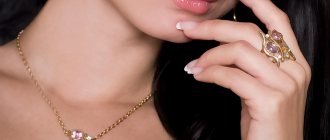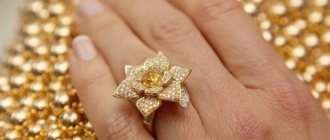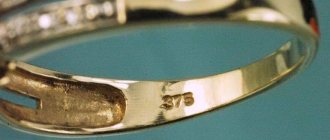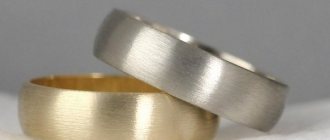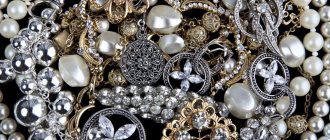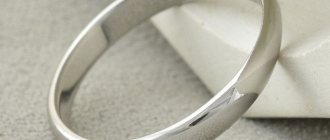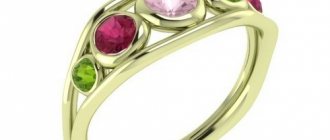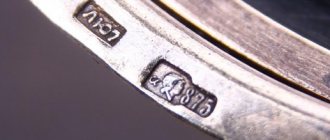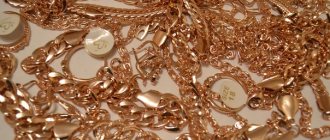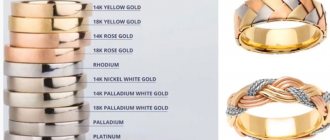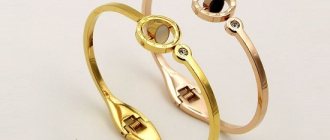Hello dear reader! We are glad to welcome you to the pages of our section. Today we will talk about gold, or more precisely, about a common question among jewelry buyers - which gold standard is better, 583 or 585? Young people often do not know the difference between two similar markings, but people of the older generation can tell a lot about the marking, popular in Soviet times - 583.
So, what is the difference between two similar gold markings and how to make the right choice when purchasing products?
Sample 583 as an echo from the USSR, the history of its appearance, its features and composition
From the very beginning of its existence, the USSR adhered to its own policy. The country strived for independence and isolation from the rest of the world, which was evident even when creating jewelry.
Gold jewelry.
Jewelry works of the USSR The whole world used the carat system to determine precious alloys. The USSR followed its own path, introducing the metric measurement system.
Throughout the world, pure gold was equivalent to 24 carats. The value of the alloy used to create jewelry was equal to the number 14 in the carat system. In the USSR, 14 was divided by 24, and the result was multiplied by 1000. The resulting non-integer result was rounded, resulting in the number 583.
This is how a real Soviet-era brand was formed - 583 alloy. The percentage of pure material from the total mass of precious metals was 58, but sometimes a slight plus error was observed. 33% was copper, the remaining 8% was silver.
What does color depend on?
Many people, including people who are interested in collecting gold jewelry, are firmly convinced that the color or shade of an item directly depends on the standard of the gold from which it is made. This is simply a widespread misconception.
The color of a gold item depends solely on the impurity material that is added to the gold itself in this alloy. This is it in short. Jewelers can talk about this in more detail for hours, telling what properties the presence of a particular additive and its concentration gives to a gold alloy. Knowing what types of gold there are and what is best for certain purposes in terms of the strength of the alloy, you can choose the color.
Thus, different alloys (metal additions) give different shades to the gold alloy:
- silver gives a greenish tone and enhanced strength characteristics;
- the addition of copper gives the alloy a whole range of red undertones (from rich “copper-red” to soft pink);
- nickel imparts a pale yellow tint, which is why it is used to make so-called white gold;
- cadmium adds a light green color to the alloy;
- zinc, like nickel, brightens the alloy and gives an almost invisible light green undertone;
- palladium, which significantly increases the refractoriness of the metal alloy, gives a soft “flesh” tone;
- Platinum most intensely of all alloys discolors the gold alloy and removes the yellow tint.
Turkish gold and the introduction of GOST standards for testing
In the 80-90s, imported 585 standard began to appear on Soviet shelves. It was massively imported into the country from Turkey. Citizens of the USSR immediately began to buy the wonder; yellow Turkish gold was very different from red Soviet gold.
The jewelry from Turkey was of disgusting quality; the composition contained gold foil. The jewelry became deformed, turned black, and broke.
What was happening caused a wave of indignation on the part of Soviet citizens. The Turkish 585 marking disappeared from the stores, and in its place the display cases were again filled with 583 gold of the highest category.
They stopped producing this alloy only in 1995, when the country had to adopt new GOST standards.
The most popular sample
Russian standards do not allow the use of gold below 375 in the jewelry industry. Once upon a time, products made from it were quite common in the country, but gradually they were replaced by crafts in which the precious metal content was already 58.3%.
The demand for the 583rd sample became possible thanks to the improvement in the financial situation of consumers, who began to invest money in things that cost more. Perhaps, for many years this sample was the only one on the shelves of jewelry stores in the USSR, while the 750th was extremely rare.
Gold for export. Reasons for switching to 585 sample
The USSR collapsed, the Iron Curtain collapsed completely, and it became necessary for the country to enter the European market.
The world refused to accept the “USSR brand” as an equal. A snag arose - when converted to the carat valuation system, the value of the 583 sample was 13.9 carats, instead of the proper 14. For Soviet products, they offered a lower price than for similar ones, but corresponding to world standards.
There was a need to introduce a new standard, the country switched to the well-known alloy 585.
The famous Soviet standard - 583 gold
Different “name” of one sample
In Soviet times, the most popular was the 583rd sample - and today products from the mid-20th century “made in the USSR” are highly valued by jewelers all over the world. In fact, the current 585th sample of factory-made jewelry is the same 583rd, only a little “modernized”.
But the arrival of higher grades in the world of jewelry was not very rosy - in the late 80s and early 90s, the gold market was flooded with low-grade Turkish rings, which in fact almost fell apart after a short time. In about 10-15 years, the gold jewelry market pushed the low-quality “crafts” of Turkish artisans into the tourist niche of ethnic souvenirs, and the 585th hallmark itself, factory-made with the hallmarks of Russian and Ukrainian factories, became quite highly valued on the world market.
So, when thinking about which gold standard is better - 585 or 583, we just choose between the “year of birth” of the ring or earrings: before perestroika or in post-Soviet times.
The main differences between samples 583 and 585
Many people believe that when switching to a global model, the “advice brand” only changed the numbers in the name of the sample, but in fact there is a difference.
It is these differences that contribute to the fact that buyers give preference to one or another alloy.
The ratio of precious metal and impurities
The first difference is the gold content. The 583 sample contains 0.2-0.4% less of this noble metal than the generally accepted 585 sample. The discrepancy may be quite insignificant, but it exists. The remaining 33.5% is allocated to copper, 8% to silver, there is no difference here.
Precious metals and impurities
Gold tone
The 583 alloy is more characterized by a red tint. The precious metal was used for minting coins, so the resulting money was often called “chervonets”.
Works with a mark of 585 are often yellow.
But deviations are normal for both alloys, with shades of 14 different colors found.
Type of mark
Initially, mark 583 depicted, in addition to numbers, a male profile and a hammer. Later, the print was changed, and an image of a star, sickle and hammer appeared, which were firmly associated with the USSR.
The modern hallmark for 585 gold looks like an imprint of a woman looking to the left.
Soviet gold - ring with stone
Alloy purity errors
Although both precious metals are equal to 14 karats, each is subject to slight individual uncertainty regarding the presence of pure gold. For 583 alloys, an error of 3% in both directions is considered normal. For 585, the deviation from the purity volume norm can only be in the positive direction - up to 5%.
Differences in GOST standards and quality
And yet there is a difference between the 585th and 583rd samples. It lies in the difference in requirements for one and another alloy. For the latter, the deviation in the precious metal content in the total mass can be 3 units, both upward and downward, that is, the alloy can be either 580th or 586th fine. In 585, a deviation of 5 units is allowed, but the remedium (deviation, tolerance) can only be positive. Thus, jewelry with a pure gold content of 59% has the right to exist, but with 58% it is considered defective. And yet, the deviations from the norm are so small (the largest difference between gold of both samples cannot exceed 1%) that the debate about which gold is better loses its meaning. Maybe someone will be more pleased to know that the manufacturer put a little more precious metal in them than they should have.
It is worth adding that a negative attitude towards 58.5% gold was formed in the years when the so-called Turkish gold predominated in imported goods. In most cases, it was of disgusting quality, from which nothing good could be expected. Crafts from Turkey clearly did not live up to the stated standard. At the same time, consumers could compare imported products with the contents of boxes purchased during the Soviet years. It was possible to tell by touch the difference between a Turkish craft and a piece of jewelry made at one of the Soviet jewelry factories.
Visually you can't tell the difference
Today, the question of bad gold can be removed, since stores offer a wide range of high-quality products of almost any standard, and even the most demanding jewelry lover can choose them to suit their taste.
Where can you find 583 gold?
Works using such an alloy are a real rarity in the showcases of modern jewelry outlets. You should try your luck with the search in private workshops, antique shops, pawn shops, and online auctions.
Sometimes such products are found at thematic exhibitions dedicated to the life of Soviet people.
Buying jewelry at a pawnshop
Which type of jewelry is better to choose?
It all depends on a person’s taste - some people like massive products, while others prefer intricate airy decorations. In the first case, you can purchase products from high-quality alloys, but you should prepare in advance for big expenses.
Elegant and sophisticated jewelry made from low-grade gold often indicates the good taste of their owner. Contrary to the established belief that only pure gold does not tarnish over the years, proper care and compliance with all operating rules will allow you to enjoy the pristine beauty of your products for many decades.
Modern jewelry art has almost perfectly studied all the features of the ligature, and by choosing the right composition of the alloy, an experienced jeweler can easily ensure that gold with a low purity will not differ in appearance from a more expensive version. It is worth showing individuality when choosing jewelry, not relying on samples, but choosing really beautiful things.
Soviet gold - the standard of quality: myth or truth
Everyone knows that the USSR placed emphasis on quality and long-term service in production. Numerous reviews of products from those times confirm this rule. Jewelry created from the Soviet 583 alloy was truly distinguished by its resistance to various types of damage, reliability, and wear resistance.
Many people still have earrings, rings, and bracelets from those times at home. You can see that the years have not affected the appearance of the products. They will look like new if they are cleaned of natural deposits.
All products of the USSR were produced in compliance with GOST and the strictest technological rules. Low quality was considered unacceptable.
Gold ring with the hallmark 750
The party never spared precious metals for production. This is especially noticeable when you compare standard wedding rings from that era to those of today.
A ring made by craftsmen from the USSR era will be much thicker and heavier.
It is worth agreeing that the characteristics of 583 samples were somehow superior to modern analogues. Under the USSR, this alloy had a reputation as the most reliable, but it still cannot be called a standard of quality.
The most common “golden” colors
If you look closely at any gold jewelry, you can accurately determine its “additional” color.
- White, very fashionable in recent years, is obtained using silver, platinum, palladium and nickel. The “economical” option uses zinc, nickel and copper as alloys.
- The red one uses copper as a base, plus a little silver.
- The purple color is achieved by combining palladium, cobalt and aluminum with a gold base.
- Blue, a rather rare two-component alloy, is achieved by combining gold with “regular” iron.
- Green is an addition of silver and cadmium. If tellurium is added to gold instead, the result will be a delicate light olive color.
- Black color can be obtained by adding nickel and cobalt to the base in a certain proportion.
It is worth saying that “colored” gold is always more a tribute to fashion than an investment. For real investments, as before, people use solar metal of the highest standard in the classic “golden” color.
Caring for 583 and 585 gold
Gold alloys tend to darken due to impurities in their composition. Contact with human skin, different temperatures, and other negative external factors also contributes to changes in appearance.
The best way to care for any precious item is to periodically visit a jewelry workshop. Our experts can clean and polish your jewelry, giving it a shiny new shine.
You can care for gold at home in the following ways:
- You need to place the decoration in a mug containing a soap solution and 4 drops of ammonia for 25-30 minutes. Next, the product will need to be rinsed with running water and wiped dry.
- A similar method, but in a container you will need to mix water with 2 tablespoons of salt. The decoration can be left for half a day.
- For the third method, you will need ceramic dishes, food foil and soda. Cover the bottom of the container with foil, dissolve 2 tablespoons of soda in a mug of water, and pour the liquid into the container. Place the product in the resulting mixture, leave for half a day, and then wipe dry.
Important! Avoid contact of 583 and 585 gold with alkaline reagents. Be sure to remove rings before cleaning or use rubber gloves. Household chemicals often contain aggressive substances.
